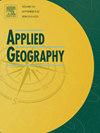Locational choices of Chinese overseas returnees: The intertwined roles of urban amenities and economic opportunities
IF 5.4
2区 地球科学
Q1 GEOGRAPHY
引用次数: 0
Abstract
An increasing number of Chinese international students are choosing to return to China after completing their studies abroad. Despite this trend, the factors influencing their choice of employment city within China remain understudied. Using resume data from the “Maimai” online professional social networking platform, this study illustrates the geographic distribution of Chinese overseas returnees. By employing a random forest model, we join the job-versus-amenity debate on human capital migration by investigating the relative importance of economic factors and amenities. The findings demonstrate that overseas returnees are predominantly clustered in eastern cities, particularly Beijing and Shanghai, forming a “dual-core and multi-center” pattern. Economic factors, such as the average annual wage and the average house prices, are the primary determinants influencing the choices of employment city for returnees. Urban amenities, particularly consumer and cultural facilities, and social atmosphere, also contribute to attracting returnees. These factors exhibit threshold effects, exerting significant influence only beyond specific values. Furthermore, the effect of amenities is largely confined to cities with higher average annual wages. This study reveals that the attractiveness of urban amenities to talent differs across locations with varying levels of economic development, calling for a deepened understanding of the dynamics behind talent migration.
中国海归的区位选择:城市便利设施与经济机会的交织作用
越来越多的中国留学生选择在国外完成学业后回国。尽管有这种趋势,但影响他们选择就业城市的因素在中国仍未得到充分研究。本研究利用“买买”在线职业社交平台的简历数据,说明了中国海归的地理分布。通过采用随机森林模型,我们通过调查经济因素和便利设施的相对重要性,加入了关于人力资本迁移的工作与便利的辩论。研究结果表明,海归主要集中在东部城市,特别是北京和上海,形成了“双核多中心”的格局。经济因素,如平均年薪和平均房价,是影响海归就业城市选择的主要决定因素。城市的便利设施,特别是消费和文化设施,以及社会氛围,也有助于吸引海归。这些因素表现出阈值效应,只有超过特定值才会产生显著影响。此外,便利设施的影响主要局限于平均年薪较高的城市。该研究表明,随着经济发展水平的不同,城市便利设施对人才的吸引力也会有所不同,因此需要深入了解人才迁移背后的动态。
本文章由计算机程序翻译,如有差异,请以英文原文为准。
求助全文
约1分钟内获得全文
求助全文
来源期刊

Applied Geography
GEOGRAPHY-
CiteScore
8.00
自引率
2.00%
发文量
134
期刊介绍:
Applied Geography is a journal devoted to the publication of research which utilizes geographic approaches (human, physical, nature-society and GIScience) to resolve human problems that have a spatial dimension. These problems may be related to the assessment, management and allocation of the world physical and/or human resources. The underlying rationale of the journal is that only through a clear understanding of the relevant societal, physical, and coupled natural-humans systems can we resolve such problems. Papers are invited on any theme involving the application of geographical theory and methodology in the resolution of human problems.
 求助内容:
求助内容: 应助结果提醒方式:
应助结果提醒方式:


